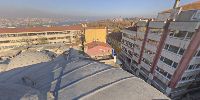© 2008 Ugur Akbulut, All Rights Reserved.
---History of Cagaloglu Hamami--- The Cagaloglu hamam was constructed in 1741 and is the last hamam to be built after a long period during the Ottoman Empire. It was constructed in Istanbul Eminonu, in Alemdar, on Hilal-i Ahmer street as a cifte public hamam to bring revenue for the library of Sultan Mahmut the first situated inside the mosque of Ayasofya. When we take a look at the names of the head architects of that time we can say that it was begun by Suleyman Aga finished by Abdullah Aga. It is the last example of its kind to be built in Istanbul and is a successful hamam that is still operational in our time. The door of the women’s section is on a side street called Hamam while the mens' entrance is from the main road with two marble columns with classic stalactite capitals on both sides. In time when the street was elevated, the mens’ section is reached by a staircase of 10 steps. The architecture of the door is contrary to eclectic Turkish style. On the tablet above the door is a long inscription of 7 lines and 28 verves.
The high and wide camegah is joined to the large dome by segmented corner trumpet-like vault panels. In the middle is a pool with a waterjet of great artistic value. The windows are placed between the vault panels in threes. On the top of the dome is a lantern for illumination. There is a sirvan in the camegah with rooms for undressing. The sogukluk is entered through a double door from the camegah and is covered with seven barrel vaults and a half sphere small dome.
The domes are supported by arches and columns. There are eight arches on eight marble columns supporting the dome in the sicaklik. In the center is the marble gobektasi, surrounded by halvets in the four corners and three sofas in between. The sofas are covered with semi domes. There is a square garden between the undressing room of the womens' section and the camegah of the mens' section. The beginning of the camegah and the sogukluk is different from classis plans. The sogukluk is also separated by two columns into three sections. In the middle is a dome. The sicaklik is the same as in the mens' section.
Have you ever been in a Turkish Bath?
If you haven't, you've missed one of life's great experiences and never been clean! Ours was built by a sultan more than 300 years ago. Although the date of the construction and the name of the architect of the hamam is not known. It is said to have been built in the beginning of the 18th. century. It is also Said that construction is one of Sinan's works of art. These double baths in which only the changing-rooms have been changed since 1969-1971 now consist of two parts, one of women and the other for men in a 2834 sq.m area. King Edward John VIII, Kaiser Wilhelm, Franz Liszt and Florance Nightingale have all been here for a royal experience. Besides today's well known personalities King Fahd, Rockefeller, Tony Curtis, Richard Harrison came to Cagaloglu Hamami during their visit to Istanbul. In this excellent three hundred year old Turkish bathing temple one hundred and thirtyeight TV films have been shot. Six of them were productions for German TV. Seven of them were Thematic Films (Indiana Jones) and one of them a commercial for visa card. The world press has written about the wonderful arthitecture many time. Four times in the New York Times and Three Times in the pages of Geo. The press has much praised this bathing maabit. There is Mikveh for ladies of jewish society



 Tap or click the zoom icon in the bottom right corner of the picture to switch between in-page and fullscreen view
Tap or click the zoom icon in the bottom right corner of the picture to switch between in-page and fullscreen view